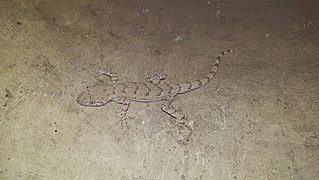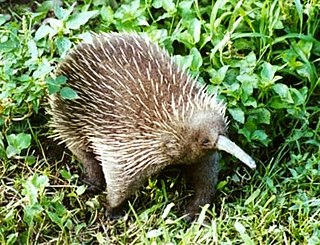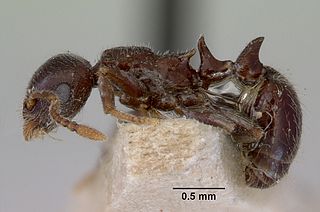Related Research Articles

Beetles are a group of insects that form the order Coleoptera, in the superorder Endopterygota. Their front pair of wings are hardened into wing-cases, elytra, distinguishing them from most other insects. The Coleoptera, with about 400,000 species, is the largest of all orders, constituting almost 40% of described insects and 25% of all known animal life-forms; new species are discovered frequently. The largest of all families, the Curculionidae (weevils), with some 83,000 member species, belongs to this order. Found in almost every habitat except the sea and the polar regions, they interact with their ecosystems in several ways: beetles often feed on plants and fungi, break down animal and plant debris, and eat other invertebrates. Some species are serious agricultural pests, such as the Colorado potato beetle, while others such as Coccinellidae eat aphids, scale insects, thrips, and other plant-sucking insects that damage crops.

Stag beetles are a group of about 1,200 species of beetles in the family Lucanidae, presently classified in four subfamilies. Some species grow to over 12 cm (4.7 in), but most are about 5 cm (2.0 in).

Mediodactylus is a genus of Gekkonidae (gecko) family. It contains the following species:

The insects of the beetle family Chrysomelidae are commonly known as leaf beetles, and include over 37,000 species in more than 2,500 genera, making up one of the largest and most commonly encountered of all beetle families. Numerous subfamilies are recognized, but only some of them are listed below. The precise taxonomy and systematics are likely to change with ongoing research.

The longhorn beetles are a cosmopolitan family of beetles, typically characterized by extremely long antennae, which are often as long as or longer than the beetle's body. In various members of the family, however, the antennae are quite short and such species can be difficult to distinguish from related beetle families such as the Chrysomelidae. The family is large, with over 26,000 species described, slightly more than half from the Eastern Hemisphere. Several are serious pests. The larvae, called roundheaded borers, bore into wood, where they can cause extensive damage to either living trees or untreated lumber. A number of species mimic ants, bees, and wasps, though a majority of species are cryptically colored. The rare titan beetle from northeastern South America is often considered the largest insect, with a maximum known body length of just over 16.7 cm (6.6 in). The scientific name of this beetle family goes back to a figure from Greek mythology: after an argument with nymphs, the shepherd Cerambus was transformed into a large beetle with horns.

The long-beaked echidnas make up one of the two extant genera of echidnas, spiny monotremes that live in New Guinea. There are three living species and two extinct species in this genus. The extinct species were present in Australia. Echidnas are one of the two types of mammals that lay eggs, the other being the platypus. The echidnas retain reptilian features such as egg-laying but display mammalian features such as fur and lactation.

The eastern long-beaked echidna, also known as Barton's long-beaked echidna, is one of three species from the genus Zaglossus to occur in New Guinea. It is found mainly in the eastern half at elevations between 2,000 and 3,000 metres.

Cleridae are a family of beetles of the superfamily Cleroidea. They are commonly known as checkered beetles. The family Cleridae has a worldwide distribution, and a variety of habitats and feeding preferences.

Sclater's whistler or the hill golden whistler, is a species of bird in the family Pachycephalidae found in the highlands of New Guinea. Its natural habitats are subtropical or tropical moist lowland forests and subtropical or tropical moist montane forests.
Chirostoma bartoni, the Alberca silverside, was a species of neotropical silverside endemic to the Lerma River basin of Mexico. Typical adult specimens were approximately 7.1 cm in length.
Barton's cichlid, is a species of cichlid endemic to Mexico where it occurs in the basin of the Panuco River where it can be found in lagoons and rivers. This species can reach a length of 18 centimetres (7.1 in) SL. It can also be found in the aquarium trade. The specific name honours the author, Tarleton Hoffman Bean's brother, Barton Appler Bean (1860–1947), who was assistant curator of Ichthyology at the United States National Museum.
Haplochromis bartoni was a species of cichlid endemic to Lake Victoria. This species can reach a length of 19.5 centimetres (7.7 in) SL. It has not been recorded in recent surveys but as the whole of Lake Victoria has not ben surveyed for this species the IUCN classify it as Data Deficient. This species was said by Greenwood to bear some resemblance to Haplochromis worthingtoni so he named this species after E. Barton Worthington (1905-2001) as well.
Licinus is a genus of ground beetles in the family Carabidae native to the Palearctic, the Near East and North Africa. It contains the following species:

Xylosteus spinolae is the species of the Lepturinae subfamily in long-horned beetle family. This beetle is distributed in Austria, Bosnia and Herzegovina, Bulgaria, Croatia, Italy, Montenegro, North Macedonia, Romania, Serbia, Slovenia, and Turkey. Adult beetle feeds on flowers of common filbert, and common beech.
Callimicra is a genus of beetles in the family Buprestidae, containing the following species:
Pseudacherusia is a genus of beetles in the family Buprestidae, containing the following species:
Xylosteus a genus of beetles of the Staphylinidae family, Lepturinae subfamily.

Peronomyrmex is a rare genus of ants in the subfamily Myrmicinae. Its three species are known from the east coast of Australia. With only five specimens in total, collected from four localities, Peronomyrmex is one of the world's most rare ant genera.

Nosferatu is a genus of cichlid fishes endemic to the Rio Panuco Basin and the tributaries of the adjacent Tamiahua Lagoon and San Andrés Lagoon in the states of Veracruz, Hidalgo, San Luis Potosí, Tamaulipas and Querétaro, Mexico. The genus is characterized by a prolongation in the size of the symphysial pair of teeth relative to that of the other teeth in the outer row of the upper jaw ; breeding pigmentation that consists of darkening of ventral area extending over nostrils, opercular series, and pectoral fins; depressed dorsal fin rarely expands beyond anterior third of caudal fin; and an elongated, elastic, smooth caecum adhered to a saccular stomach.
Barton's thin-toed gecko is a species of lizard in the family Gekkonidae. It is endemic to Crete. It is sometimes considered a subspecies of Kotschy's gecko.
References
| This Lepturinae article is a stub. You can help Wikipedia by expanding it. |